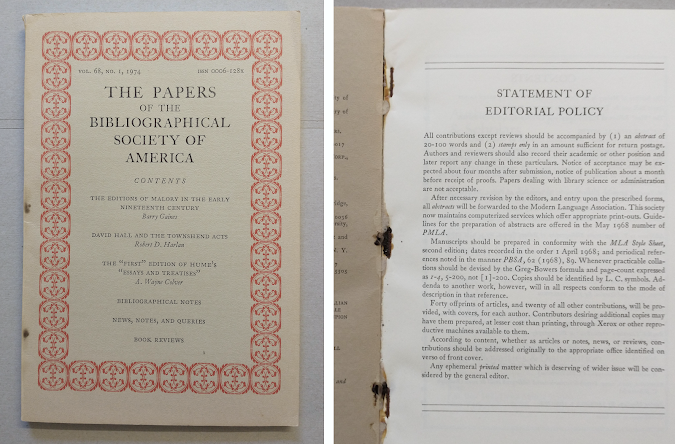Removing Gary Nored’s Staples
Purchased a small pamphlet a few months back; noted that the bookseller (they told me) had removed the staples. This reminded me of a Darryn Schneider YOUTUBE video I watched last year, Removing Staples & Why I Hate Rust Stains. Surely, Schneider asks, staples have no place in the ‘DAS BOOKBINDING world of traditional bookbinding?’ But his channel does touch upon conservation fairly frequently; and this video is about the removal of staples, not their merit as a binding style.
Prompted by this recent purchase, I looked through my own collection of pamphlets and ephemerae to see if staples and rust were a problem, something I had long ago intended to do, but never systematically got round to. In particular, I have a large collection of NECRONOMICON PRESS titles—the earliest of these are from the late 1970s—and TOLKIEN SOCIETY publications that I wanted to re-examine. It
is also common to see staples used in older publications, in particular
serial publications, periodicals, offprints, and the like.
I currently store this type of material in individual stiff polypropylene A4 letter files (from WHSMITH) or archival comic book bags; these are housed in cardboard magazine files on open shelves. Most of these publications are in typical pamphlet format, almost all stapled; technically these are ‘saddle-stitch’ bindings. In the end, I decided to
remove all staples regardless of condition.
I found staples in various states of corrosion, some in perfectly good condition, some brittle and dysfunctional. A few pamphlets had developed paper staining; unfortunately, some have irreversible paper damage/loss. Paper repairs were not something I contemplated, in most cases it was either unnecessary or simply not worth attempting.
 |
| Paper staining with loss |
I did indulge my bookbinding skills in one instance though. Gary Nored's ‘The Lord of the Rings—A Textual Inquiry’, in The Papers of the Bibliographical Society of America (vol. 68, no. 1, 1974, pp. 71–74), is a good example of a ‘side-stitch’ (or side-stapled) binding; although—curiously and usefully—still printed and folded in sections.
I have no recollection of ever having looked at the condition of the staples in my copy (purchased 2006);
the staples are partially concealed under card covers, which are
themselves glued to the spine and narrowly tipped-on to the front/back
sections. The staple damage was extensive.
Decided to rebind. Paper repairs were needed to several sections, new endpapers were added. The original sections were sewn onto new tapes, the spine glued and lined. A new cloth-covered Bradel case was made, the original covers cut-down and recessed.
The sewn page-block and new case were then brought together to create a new hardback. No staples. A thoroughly worthwhile side-project to distract from the tedious task of
staple removing, I think.
Nored's ‘preliminary’ Inquiry is seldom referenced today, but it is an important—and early—bibliographical examination of the complex publication history of The Lord of the Rings, focusing on changes made to the text in the 1960s and the bibliographical status of the second edition.
Read Nored. Check all staples.
![[The] Silmarillion; book-collecting minutiae](https://blogger.googleusercontent.com/img/a/AVvXsEi7NXZeS-e6C3roxz2c7UWFEcUEINpMfgDkihMCeoVgjBGA-K9_wE7HmJ0J5LSIJqNm8fDVUqJ5HOvdvgIHgPctu9xPEx_CjPUqrXJEyd5Q-ftA4tlo6NhRx3V9JZl-IBbGvIvBQVjE9GFyKMqd_JrWwkLEqMMbhG2m3Q3FQuyhnjhlhdpebGxovD9adS1H=s456)











.jpeg)
Comments
Post a Comment